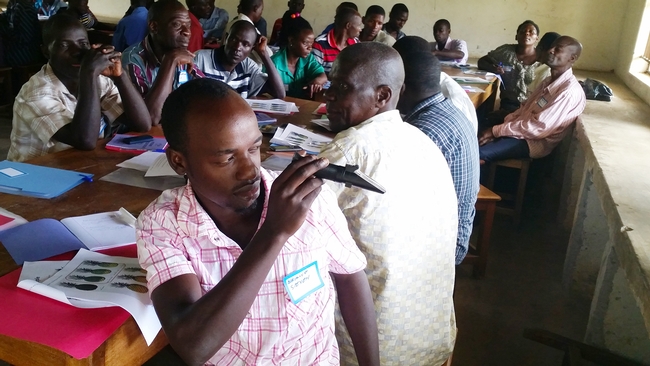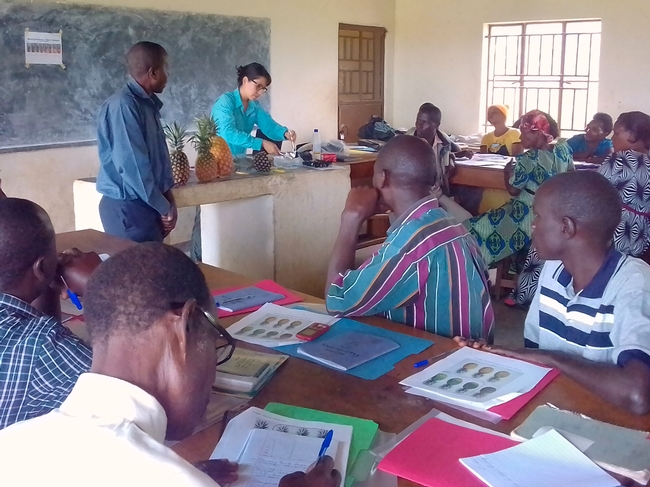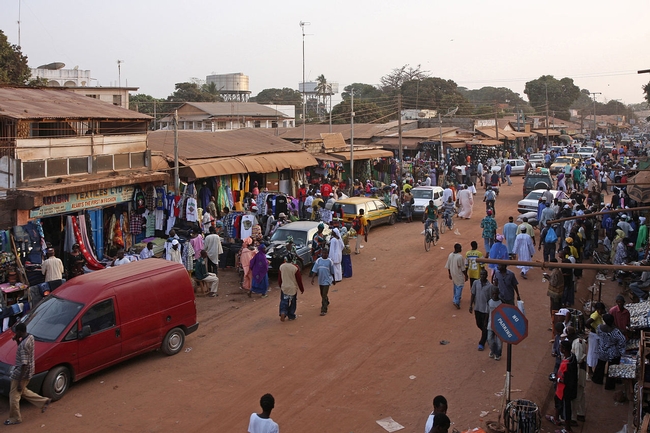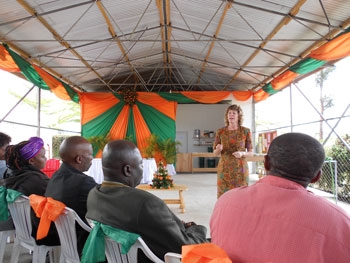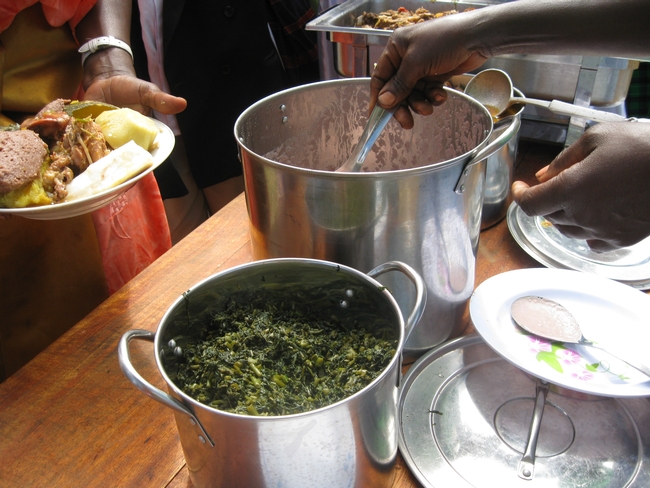Posts Tagged: Africa
Connecting with farmers over pineapple postharvest practices
At the end of a long year, sometimes it helps to reconnect with what motivates your work.
For Karin Albornoz — a Ph.D. student who works in the Diane Beckles Lab at UC Davis on molecular biology related to tomato postharvest chilling injury — that means getting out into the world to work directly with small-scale farmers.
"I spend so much time in the lab," she said. "Sometimes I spend a whole day in the lab extracting RNA or writing a paper. This reminds me why I am doing this work: to make a real-world impact."
Just over a week ago, she returned from a trip to Uganda where she did exactly that. In partnership with a local organization called Ndibwami Integrated Rescue Project (NIRP), Albornoz shared her expertise with farmers through several hands-on workshops about improving harvest practices and postharvest handling of pineapple, passion fruit and tomatoes. Her work was supported by the Horticulture Innovation Lab, an international agricultural research program led by UC Davis with funding from the U.S. Agency for International Development as part of Feed the Future, the U.S. government's global hunger and food security initiative.
Though Albornoz has worked with rural farmers before, this was her first time working in Africa.
"Everywhere I looked, things were growing. There were people working in the field, women cooking, and everyone was working with food," she said. "I know there's a lot of stigma – when you talk about Africa, you see people's faces change and they're thinking about things like drought and famine and starving children. But what I saw doesn't fit that stereotype. The challenges they are facing seem to be about not having access to opportunities."
The workshops she led are part of the NIRP organization's efforts to connect farmers with more lucrative markets that pay higher prices for quality produce.
In this 2-minute video, Karin Albornoz visits a pineapple farm, leads a pineapple training and discusses next steps for this project led by NIRP in Uganda. The video clips and photos were taken by Karin while she was working and edited by Hallie Casey for the Horticulture Innovation Lab.
For months, Albornoz has been in contact with NIRP and making plans for the farmer workshops. She prepared postharvest handling manuals for each crop — pineapple, passion fruit and tomato — and asked questions to better understand local resources and the farmers' existing knowledge.
During her 2 weeks in Uganda, she visited farmers' fields and led three full-day workshops. The first workshop for about 50 farmers focused on pineapple — starting with understanding local quality parameters for this fruit, then best practices for harvesting, sanitation, storage and transportation. The second workshop was focused on tomato, with a similar structure, and the third workshop on passion fruit.
Her favorite moment? The farmers' first chance to use a refractometer, to measure soluble solids and learn about sugar levels in the fruit. The refractometers were part of a small toolkit the organization will continue to use.
"They were excited to handle this device and see, in numbers, how the sugar levels of the fruit changed depending on the stage of maturity," she said. "Everyone in the room had a chance to try it."
The experience reinforced her commitment to working with farmers and solving agricultural problems.
"A major mistake is to think that you are going just to train or teach other people because those people are always going to end up teaching you too," Albornoz said. "I made a promise to myself years ago, a personal commitment to working with people in vulnerable situations. I have to do this. Working in agriculture can be a very powerful tool to have an impact in the world."
As Karin's mentor and an Associate Professor in the UC Davis Department of Plant Sciences and Agricultural Experiment Station, Diane Beckles supported Karin's work outside of the lab and views such an experience as important to scholarly development.
"Something magical happens when we teach and engage in outreach," Beckles said. "We often deepen our understanding of what we are teaching, and interacting and engaging with others changes us in that process. It alters how we view and think about science in a way that is positive and rewarding, even though it is not easily quantified."
More information:
- More about Trellis Fund projects with the Horticulture Innovation Lab
- Pineapple recommendations from the UC Postharvest Center
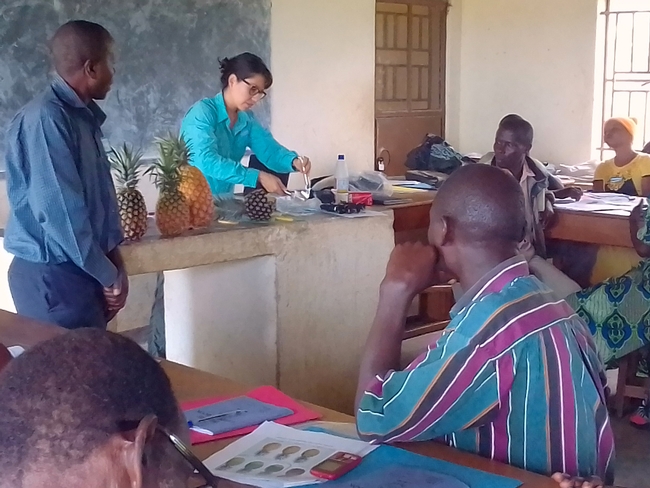
thumbnail: Karin Albornoz leads a workshop in postharvest handling of pineapple in Uganda.
Changes in breast milk sugars impact babies’ health and growth
When it comes to nursing moms and their babies, an elegant web of cause and effect connects climate, breast milk, gut microbes and infant health.
That web was clearly illustrated by a recently published study involving 33 women and their babies in the West African nation of The Gambia. The research team, including scientists from UC Davis and UC Agriculture and Natural Resources, found that complex breast milk sugars called oligosaccharides helped protect nursing babies from illness and also influenced the mixture of microbes in the infants' guts.
The researchers also showed that changes in food availability from season to season could affect the composition of the women's breast milk and the protective quality of the babies' gut microbiota. And those changes, in turn, impacted the health and growth of the breastfed infants.
Composition of breast-milk sugars and infant health
Oligosaccharides occur abundantly as more than 200 different chemical structures in human breast milk. It's been known for some time that these complex sugars contribute to infant health by supporting the growth of beneficial bacteria in the baby's gut. And these gut bacteria have been shown to play a key role in fending off infectious illnesses.
But little has been known about how changes in the composition of the breast milk sugars might affect the health and growth of infants, especially those living in areas where infection rates are high.
To explore that relationship, the researchers monitored the composition of the oligosaccharides in the mothers' milk and examined the infants' gut microbiota at 4 weeks, 16 weeks and 20 weeks after the babies were born. Then they analyzed the data, looking for possible relationships to the health and growth of the babies and the status of their gut microbes.
They found that two of the oligosaccharides, lacto-N-fucopentaose and 3′-sialyllactose, had a direct relationship to the babies' health and growth. High levels of the former were associated with a decrease in infant illness and with improved growth, measured as height for age, while the latter proved to be a good indicator of infant growth, measured by weight per age.
“Our findings provide evidence that specific human milk oligosaccharides can alter the composition of breast milk, making it more protective against infection and allowing the infant to invest energy in growth rather than fending off disease,” said the study's corresponding author Angela Zivkovic, an assistant professor of nutrition at UC Davis.
Influence of wet and dry seasons
The researchers also were curious how seasonal shifts in food availability, which significantly impact the mothers' diets, might be reflected in breast milk composition and infant health.
The Gambia has two distinct seasons, the wet season from July to October and the dry season from November to June.
The wet season is also known as the “hungry” season because it is the time of year when food supplies tend to be depleted, infection rates rise and the farming workload is highest. In contrast, the dry, or “harvest,” season is characterized by plentiful food supplies as well as significantly higher energy stores and less illness among the local people.
The researchers found that mothers who were nursing during the wet or “hungry” season produced significantly less oligosaccharide in their milk than did those nursing during the dry season.
In examining the makeup of the babies' gut microbiota, the researchers noted that most of the bacteria belonged to the Bifidobacteria genus. They also discovered that higher levels of Dialister and Prevotella bacteria were accompanied by lower levels of infection.
In addition, higher levels of Bacteroides bacteria were present in the infants' guts that had abnormal “calprotectin” – a biomarker associated with intestinal infections.
“We are very interested in which specific dietary factors influence the oligosaccharide composition of mother's milk,” Zivkovic said. “If we can find the mechanisms that change the composition of breast milk sugars, we may have a new approach for modifying the infant microbiota and ultimately influencing the health and vigor of the nursing baby.”
The study by Zivkovic and colleagues appears online in the journal Scientific Reports. The research is part of a long-running, cross-disciplinary project at UC Davis examining milk and its role in nutrition.
Funding for the study was provided by the National Institutes of Health, UK Medical Research Council, Bill and Melinda Gates Foundation, Alfred P. Sloan Foundation, and Peter J. Shields Endowed Chair in Dairy Food Science at UC Davis.
When weeds make good eats
Last week, NPR offered up a novel weed control solution for all those yellow dandelions dotting your lawn: just eat 'em. The article includes a chef's recipe for dandelion flower fritters.
The idea that weeds can be edible pops up periodically, with articles suggesting one person's weeds are another person's salad bar, highlighting chefs who “have a way with weeds,” discussing ways medieval gardeners encouraged weeds, and even suggesting ways to eat away at invasive species. But is this something we should take seriously?
“We call these plants weeds because of the way we interact with them. They're in our gardens, they're in our lawns, and they're competing with plants that we prefer to eat,” said Lynn Sosnoskie, a weed scientist at UC Davis. “But a lot of the plants that are weeds here in the United States were brought here purposefully—to be eaten.”
Sosnoskie's doctoral thesis was on just such a plant, with the tasty name of “garlic mustard.” She has also worked at length on Palmer amaranth, a pernicious weed found in cotton fields that can be glyphosate-resistant. In response to one Georgia farmer asking in exasperation if he should just eat the plant taking over his fields, she did some preliminary research into eating Palmer amaranth.
“It's probably not feasible to eat our way out of a serious weed problem,” she said. “But I certainly feel like we can investigate them as other potential food sources.”
In fact, the Horticulture Innovation Lab at UC Davis has a project that is researching three “indigenous vegetables” in Africa, two of which — amaranth and black nightshade — are considered weeds in the United States. The vegetables can be nutritious and profitable options for small-scale farmers in Kenya, Tanzania, Zambia and elsewhere.
“I think some of these weeds have a lot of potential and are underutilized,” said Stephen Weller, horticulture professor at Purdue University, who leads the indigenous vegetables project. “In eastern Africa, these vegetables are very popular. And I really think that as we get more immigrants here from that region, there is going to be a market for some of these vegetables here.”
Though he holds a Ph.D. in weed science, Weller is now figuring out the best ways to cultivate amaranth and black nightshade — instead of to eliminate them. Before he started working with these plants, common assumptions held that they should be easy to grow because, well, they “grow like weeds.”
“But we found out that growing them is more intensive than we were initially led to believe — similar to growing any other vegetable,” Weller said. “They need water, they need fertilizer, and pests are a problem.”
Caveat emptor: Though weedy plants can indeed be a source of food, both scientists cautioned against thinking of weeds as a “free-for-all forage buffet.” Some plants may be toxic, and weeds in farm fields may have been sprayed recently. It is important to be knowledgeable of the plants and how they've been grown before trying to eat one.
A postharvest program in sub-Saharan Africa promises long term benefits
In sub-Saharan Africa, postharvest losses of horticultural crops range from 30 percent to an astonishing 80 percent. Ongoing problems with food quality, safety and nutritional value are well documented. A number of past projects have identified appropriate actions, including implementing improvements in produce handling, training for regional agricultural leaders, capacity building, and small-scale infrastructure development, but these recommendations had not ever been integrated into local solutions. In 2011 the Horticulture CRSP awarded a pilot project to Diane Barrett, UC Cooperative Extension specialist in the Department of Food Science and Technology at UC Davis, Lisa Kitinoja of the World Food Logistics Organization, and Rob Shewfelt of the University of Georgia.
Since receiving funding from Horticulture CRSP, the initial focus has been developing and implementing a year-long, online training of 36 agricultural professionals in advanced postharvest technology, and building the first Postharvest Training and Services Center (PTSC) in Arusha, Tanzania, at the AVRDC – The World Vegetable Center’s Regional Center for Africa Campus.
Then, in early October 2012, when the Arusha PTSC first opened its doors, all 36 of the master trainers traveled to the center to complete the 11-day in-person segment of their training.
By mid-October the 36 “master trainers” officially “launched” the PTSC by participating in a series of training programs for local farmers in Arusha, before returning to their own countries with the designs and tools needed to launch new PTSCs and provide similar services and training. This project and all the PTSCs will provide access to training programs, adaptive research and demonstrations. These, along with the needed tools and supplies, will help to reduce postharvest losses and improve market access and incomes for small holders and women farmers throughout Africa.
“The launch of this pilot Postharvest Training and Services Center in Arusha is a great step in the direction of reducing food losses in developing countries," Kitinoja said.
She continues, "First, since we have trained 36 Africans as postharvest specialists from seven countries in sub-Saharan Africa, we now have a pool of skilled people to help us provide local training programs, demonstrations on improved postharvest practices, small-scale postharvest handling and processing technologies and innovative approaches to postharvest extension work, logistics and management of horticultural value chains. Already these young people have been implementing postharvest training activities in their own countries, and during 2011-12 they were able to reach more than 8,000 extension workers, leader farmers and horticultural entrepreneurs.
“Second, our model PTSC being piloted in Tanzania under the Horticultural CRSP postharvest extension for sub-Saharan Africa will serve as a hub for continuous activities in postharvest research, training of postharvest trainers and extension workers in East Africa, international short courses in postharvest technology, and training of local farmers in cost effective postharvest handling practices. Next week the first meeting will be held for the new Postharvest Working Group for Tanzanian researchers, and for 2013 we already have training programs scheduled on topics including improved practices for harvesting and field packing, cooling and cool storage for perishable crops, improved solar drying and packaging of dried horticultural crops.
“Third, the PTSC will provide local access for local farmers, farmers associations such as TAHA and regional extension workers to the missing postharvest tools, supplies, equipment and services that they will need in order to be able to implement the kind of improvements being promoted via the postharvest training programs being provided in Arusha. Most international projects provide education for potential beneficiaries, but very few projects provide the kind of follow-up that is needed to ensure that those who learn about new practices and technologies will actually get the chance to use them. In this case, a PTSC postharvest shop will allow the beneficiaries to invest in a wide range of options and the postharvest tools and supplies that it requires to be able to use a set of cost-effective improved practices and that leads to practical results and long-term changes, including reduced food losses and improved incomes.”
The Horticulture Collaborative Research Support Program (Horticulture CRSP) builds global partnerships for fruit and vegetable research to improve livelihoods in developing countries. The program is managed by UC Davis (directed by Beth Mitcham who also serves as the Postharvest Technology Center's Director) and funded by USAID. For more information, visit http://hortcrsp.ucdavis.edu.
More African vegetables on more plates
What will be the new food frontier? An article in the Wall Street Journal with the headline “Next Stop for Food Fanatics: Africa” predicts adventurous American palates may soon be craving sub-Saharan cuisines.
Have you heard of these?
- Nakati (Solanum macrocarpon, S. aethiopicum) Also called African eggplant, some types of nakati are eaten for their leafy greens, while others are eaten for their fruit (which can look like a tomato or eggplant).
- Cowpea leaves (Vigna unguiculata) This plant produces black-eyed peas, but the greens of the plant can also be eaten as a vegetable.
- Bbuga (Amaranthus Gracecizans) You might know this plant by its common American name: pigweed.
- Doodo (Amaranthus Dubius) Like bbuga, this type of amaranth is eaten for its leaves in many parts of Africa. In North and South America, varieties of amaranth are usually used as a grain.
- Jjobyo (Gynandropsis Gynandra, Cleome gynandra) Also called spider plant.
Many of these indigenous vegetables are rich in micronutrients such as iron, vitamin A and vitamin B. When it comes to alleviating malnutrition in developing countries of eastern Africa, indigenous vegetables offer workable solutions because they are not only nutritious, but also familiar to the region’s eaters and farmers.
But research into these vegetables has often not been a priority, even among international development professionals. Markets for these vegetables are also largely undeveloped because they are widely considered subsistence crops, often grown in small garden plots by women for their own families. But growing these crops commercially can mean increased income for smallholder farmers and improved nutrition for consumers who crave traditional foods.
Recently U.S. researchers have been working with indigenous crops like these in east African countries — with funding and support from the Horticulture Collaborative Research Support Program (Horticulture CRSP), led by Beth Mitcham at UC Davis with funding from USAID. In Kenya, Tanzania and Zambia, Stephen Weller of Purdue University is leading a Horticulture CRSP research project on production practices, seed resources, postharvest handling, marketing and nutrition of varieties of amaranth, spider plant and African nightshade.
In Uganda, Kate Scow of UC Davis is partnering with local groups to try out a new model of extension while increasing production of indigenous greens, such as nakati, bbuga and jjobyo.
Take a look at this short video for a little more background:
Just as bok choy, an Asian vegetable, has become familiar to many American households, perhaps one day you’ll find nakati or another African leafy vegetable on your plate.
In the meantime, researchers with Horticulture CRSP are working to get more African leafy vegetables into the research agendas, fields, markets and plates of our counterparts in eastern Africa.
Read more abut Horticulture CRSP and its projects around the world at http://hortcrsp.ucdavis.edu.

